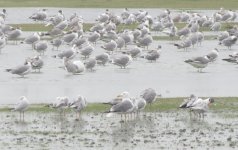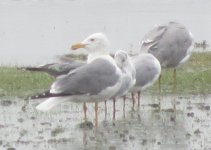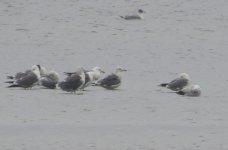KFC
Ken Tucker
Hi
I was in Sri Lanka over Christmas. Saw a large flock of gulls, most of which were Pallas' (about 3700 birds) with some that I assumed were Heuglin's (70) plus Brown-headed (500) and some Caspian Terns (100). To help me better estimate the numbers of each species, I photographed the flock in sections so that I could count them later. In the photos I came across this gull that didn't fit the ones I'd been calling Heuglin's. Any ideas?
Photo 1 shows it with the other gulls for comparison.
Photo 2 is the close up
Photo 3 shows what I was calling Heuglin's from further along the flock for comparison
I don't have any other photos of it, I'm afraid, so it's probably not identifiable with certainty.
Many thanks
Ken
I was in Sri Lanka over Christmas. Saw a large flock of gulls, most of which were Pallas' (about 3700 birds) with some that I assumed were Heuglin's (70) plus Brown-headed (500) and some Caspian Terns (100). To help me better estimate the numbers of each species, I photographed the flock in sections so that I could count them later. In the photos I came across this gull that didn't fit the ones I'd been calling Heuglin's. Any ideas?
Photo 1 shows it with the other gulls for comparison.
Photo 2 is the close up
Photo 3 shows what I was calling Heuglin's from further along the flock for comparison
I don't have any other photos of it, I'm afraid, so it's probably not identifiable with certainty.
Many thanks
Ken








